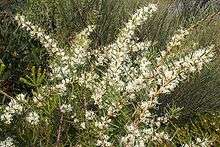Hakea teretifolia
| Hakea teretifolia | |
|---|---|
 | |
| H. teretifolia - Botany Bay National Park, Kurnell, New South Wales | |
| Scientific classification | |
| Kingdom: | Plantae |
| (unranked): | Angiosperms |
| (unranked): | Eudicots |
| Order: | Proteales |
| Family: | Proteaceae |
| Subfamily: | Grevilleoideae |
| Genus: | Hakea |
| Species: | H. teretifolia |
| Binomial name | |
| Hakea teretifolia (Richard Salisb.) Britten, 1796 | |
| Wikimedia Commons has media related to Hakea teretifolia. |
Hakea teretifolia, commonly known as the Dagger Hakea, is a species of woody shrub of the Proteaceae family common on heathlands in coastal Eastern Australia from Northern New South Wales through to Victoria and Tasmania. A very prickly shrub, it is rarely cultivated but easy to grow.
Taxonomy
It has a complicated taxonomic history; initially named as Banksia teretifolia by Richard Salisbury,[1] then taxonomically correctly as Hakea glabra by Heinrich Schrader in 1797 in his newly described genus Hakea.[2] Conchium longifolium was another subsequent name and Antonio José Cavanilles called it Hakea pugioniformis.[3] The original specific epithet teretifolia is derived from the Latin teres "rounded" and folium "leaf".[4] The full name for the species is therefore Hakea teretifolia (Salisb.) Britten [5]
It was classified in Hakea sect. Hakea series Pubiflorae by George Bentham in his Flora Australiensis,[6] but was reclassified on its own in the Teretifolia group in the 1999 Flora of Australia treatment.[7]
Two closely related subspecies are recognised, the nominate subspecies teretifolia and H. t subsp. hirsuta.
Description
A prickly shrub, it can reach 3 m (10 ft) in height. It has spirally arranged thick tough succulent spike-tipped leaves. Flowering occurs in summer though some may be seen in winter. The small white inflorescences occur on branches and consist of 4-8 individual small flowers. These are followed by sharp pointed (dagger-shaped) seed pods from where the plant gets its common name.[7]
Subspecies hirsuta can be distinguished by its more densely hairy perianths and pedicels.[7]
Distribution and habitat
H. teretifolia subsp. teretifolia ranges from Coffs Harbour south through the Sydney region to the Budawang Range in New South Wales. Subsp. hirsuta occurs further south from the Sydney region through to Tasmania with a separate population in the Grampians in western Victoria.
It is found on sandstone soil-based heathland, and can form dense thickets with the Heath Banksia (Banksia ericifolia) and Scrub She-oak (Allocasuarina distyla);[8]
Cultivation
It is rarely cultivated but an easy plant to grow provided it has a sunny aspect. Unlike many other proteaceae it can be tolerant of poor drainage. Its extremely prickly foliage can make a good deterrent.[9] When planted in clumps, this species provides an excellent shelter for small birds such as superb fairywrens (Malurus superbus) and the smaller sized honeyeaters. It can also prove a prickly deterrent for burglars.[10]
References
- ↑ Salisbury R (1796) Prodr. Stirp. Chap. Allerton 51.
- ↑ Schrader H, Wendl. J. C. (1797) Sert. Hannov. 27, t. XVII.
- ↑ Cavanilles AJ (1800) Anales Hist. Nat. 1: 213, t. 11
- ↑ Simpson, D.P. (1979). Cassell's Latin Dictionary (5 ed.). London: Cassell Ltd. p. 883. ISBN 0-304-52257-0.
- ↑ "Hakea teretifolia (Salisb.) Britten". Australian Plant Name Index (APNI), IBIS database. Centre for Plant Biodiversity Research, Australian Government.
- ↑ Bentham, George (1870). "Hakea". Flora Australiensis. Volume 5: Myoporineae to Proteaceae. London: L. Reeve & Co. pp. 491, 500.
- 1 2 3 Barker RM, Haegi L, Barker WR (1999). "Hakea". In Wilson, Annette. Flora of Australia. Volume 17B: Proteaceae 3: Hakea to Dryandra. CSIRO Publishing / Australian Biological Resources Study. pp. 94–95. ISBN 978-0-643-06454-6.
- ↑ Fairley, Alan; Moore, Philip (2000). Native Plants of the Sydney District:An Identification Guide (2nd ed.). Kenthurst, NSW: Kangaroo Press. p. 173. ISBN 0-7318-1031-7.
- ↑ Holliday, I (2005). Hakeas: A Field and Garden Guide. Sydney: New Holland Press. pp. 204–205. ISBN 1-877069-14-0.
- ↑ Dengate, John (2000). Attracting Birds to Your Garden. Sydney: New Holland Press. p. 21. ISBN 1-86436-411-4.